What it feels like
- thanks to Mental Health America and Huffington Post.
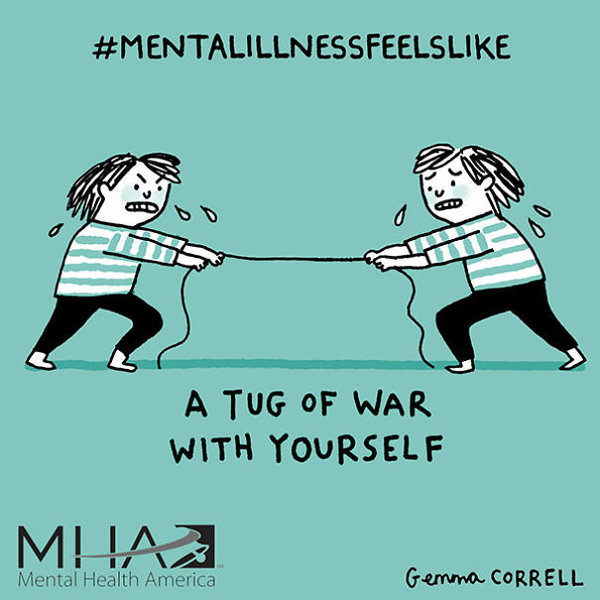
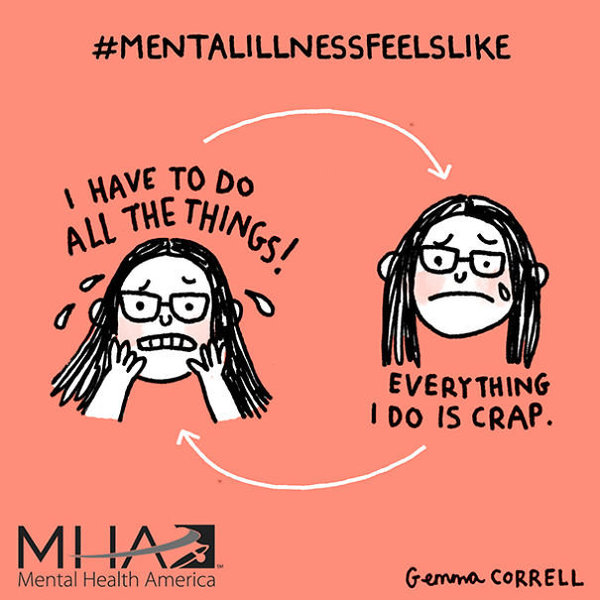
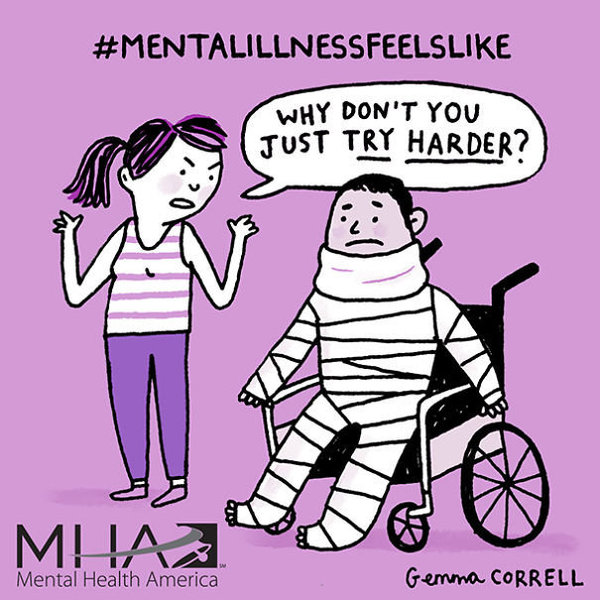
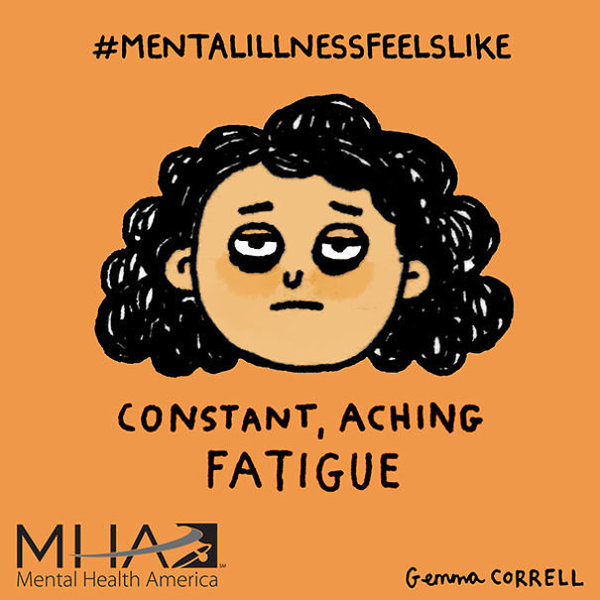
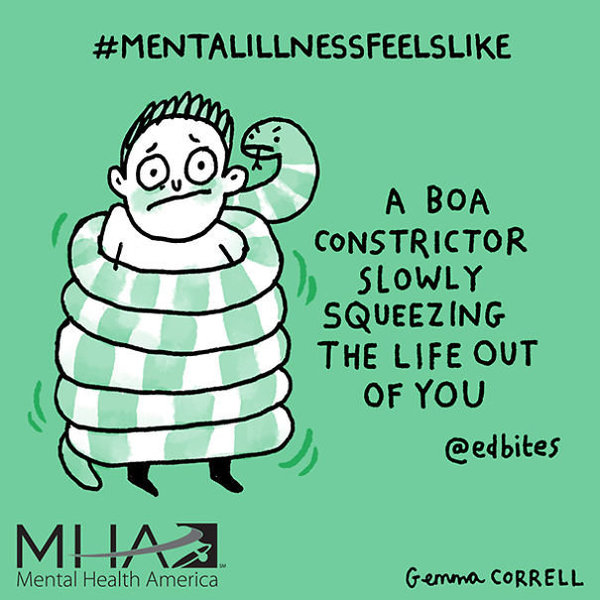
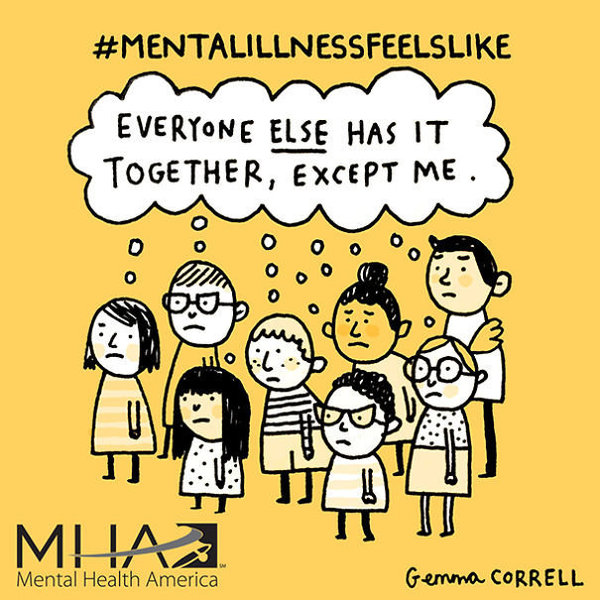
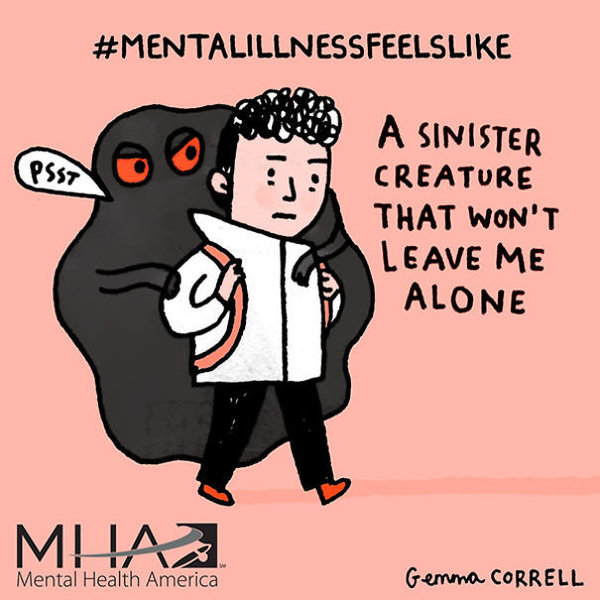
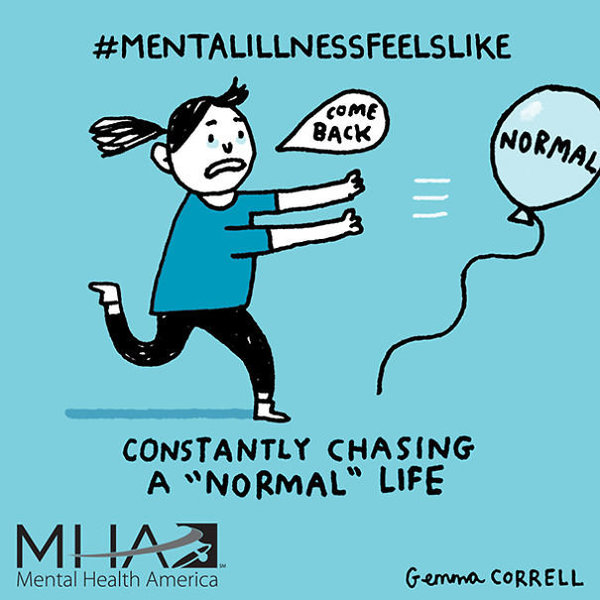
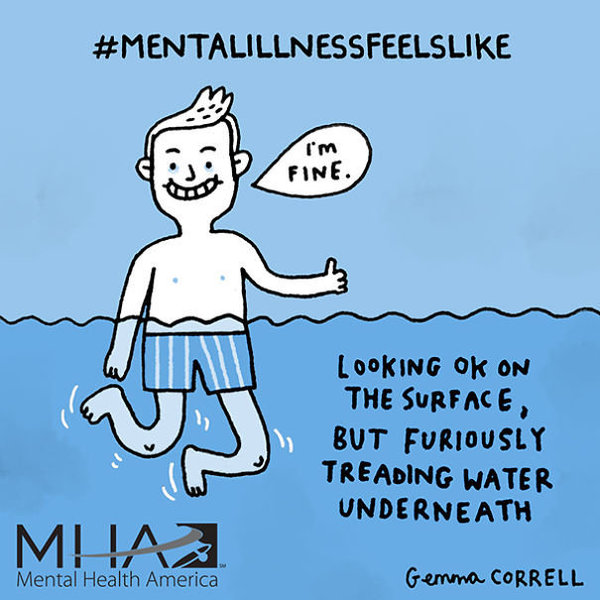

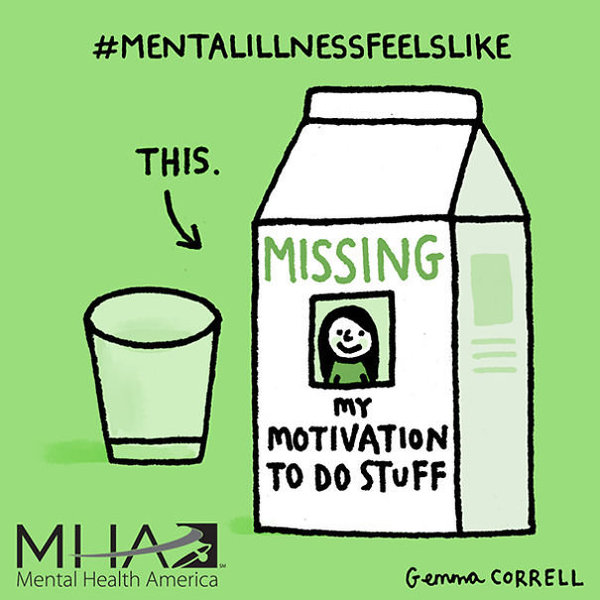
Back to School Tips

Establish an early routine
- Planning for a good school year starts in the summer. Begin establishing a "back to school" routine at least two weeks prior to school starting to minimize stress and help with the transition.
- Adjust their bedtime schedule. Many kids (including teens) need as many as 9 or more hours of sleep. Adjusting their schedule ahead of time will help your child be ready when school starts.
- Promote good eating habits. Plan for ways to ensure your child gets a healthy breakfast to help prepare them for the school day. If you pack your children's lunches, go grocery shopping with them and allow them to pick out healthy foods they’ll enjoy. Kids tend to eat what they’ve picked out themselves.
- See if your child is interested in visiting the school prior to the first day. Take a walk around the school with your child to locate his or her classrooms, lunchroom, playground and restrooms. If you can’t visit, take a virtual tour on the school’s website. There may be photos of the classroom, playground, school staff, required school supplies, schedules, etc. This will help keep your child from feeling lost on the first day.
- Engage with school staff. Identify school functions or parent volunteer opportunities to stay involved in your child's education.
- Talk to your child about expectations for the upcoming school year. Ask about specific concerns they might have about the new school year.
- If you establish rules, make sure they are simple, age appropriate, clear, and can be consistently enforced. Introduce them before the school year starts, and try not to change rules often.
- Praise and encourage your child to become involved with school activities and to try new things. Encourage your child to try to make new friends and to be a friend. School is a "social hub" that can be a very lonely place without a friend or two. Encourage them to reconnect with a friend before the start of school. Talk about strategies for
- making new friends.
Know that your child's mental health is just as important as their physical health; your involvement will help him or her develop a healthier life.
For the full article, and other helpful back-to-school info go to: http://www.mentalhealthamerica.net

New Teen Group Starting
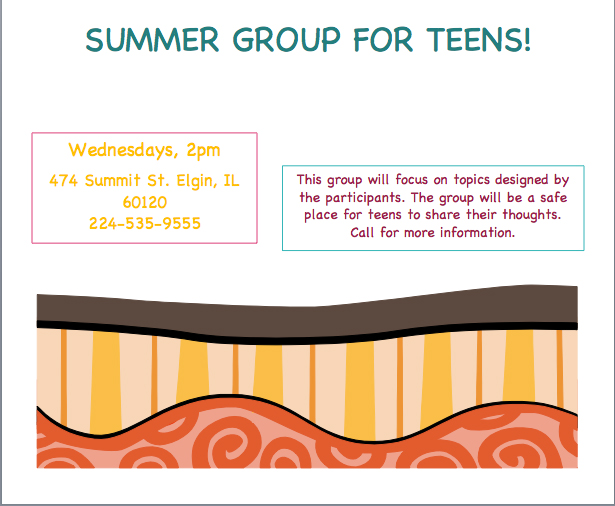
Phoenix Family Center is beginning a new Summer group for teens. The first meeting will be this coming Wednesday, June 1st at 2pm.
Mental Health Awareness Month

By now, you are probably aware of this. So instead of the typical articles about mental health, we thought that we would use broader strokes and share this article by Larry Shushansky of HuffingtonPost.com. After the article I have included a copy of the presidential proclamation for Mental Health Awareness.
Don’t Simply Turn Away
Did you know that there are 35 national health observances that take place during the month of May?
To name a few: Hepatitis and Stroke Awareness Month, Mental Health Month, Teen Pregnancy Prevention, National Physical Education and Sport Week, National Bike to School Day and World Autoimmune Awareness Day. There are a total of 213 national health observances throughout the year.
Some might ask:
“Is of all this necessary?”
“Aren’t 213 observances a bit of an overkill?”
“Why so many?”
We often hear these questions because the majority of people don’t really understand the hardships, difficulties, and struggles of others; or if we do care, we’re too busy or too financially strapped to do anything about it. People question, “Can we really be expected to spend our free time and resources on such a long list of special interest groups?” Some might say, “That’s simply unrealistic. I don’t have enough time, energy or money for that!”
And this is true. You don’t, and neither do I.
Nobody has time to constantly be aware of other people’s health struggles every day. And this is exactly the reason we need so many “awareness” months, weeks, and days.
The people represented by awareness organizations would be without representation, and without services and funding to work towards becoming healthier. They would lack preventive measures and treatment were it not for those who advocate for them. Without advocates, those who are suffering would be the “unknown and unseen” in our society. Living, basically, alone without help and suffering without hope.
Let’s look at some groups who are typically represented by awareness observances:
We don’t acknowledge this side of life, because for most of us, unless we’re personally touched by some illness, struggle, or condition, we tend to turn away and pay little or no attention. We may see or hear about special populations periodically, but it generally goes in one ear and out the other, without giving it much thought. It’s similar to what many people feel when seeing homeless person on the street, everyone has an opinion, but that’s the extent of our interest and action.
So then, what can be done?
In an ideal world, each of us would have the kind of compassion and understanding that opens us up to the belief that everyone in our society deserves advocacy, support, and funding for the care they need. In an ideal world, each of us would get behind the idea that whatever malady someone experiences, that person, at a bare minimum, is due the respect it takes for them to be seen as deserving of services. In that ideal world, there would be a way for each of us to advocate for solutions, not just for problems of our own, but for the problems of people who have difficulties we cannot understand.
While we don’t live in an ideal world, each of us can help work towards one.
National health observances can sharpen our awareness, making us a little more sensitive to people in need, which then motivates us into action. Maybe wecontribute when we usually would not have. Maybe our conversations about the disadvantaged change. Maybe we shift our thinking. Maybe we volunteer when we wouldn’t have before. Maybe we become more active by replying to social media posts. Maybe we increase our knowledge and understanding of the dangers of radon (National Radon Action Month), or learn about the trauma experienced by a family having a child with birth defects (National Birth Defects Awareness Month). Maybe we start to ask questions about heart disease (Heart Disease Awareness Month) or cancer (National Cancer Prevention Month). Perhaps, as we are offered the opportunity to observe, we begin to grasp the injustices of racial, ethnic and religious discrimination.
So the next time you think that public awareness of a special interest seems like too much, or you roll your eyes at another awareness month, think about what you are doing to perpetuate a situation that requires such advocacy. Then, beIndependent Enough to make a change — a shift — in your own thinking and behavior when you see a person in a wheel chair, hear of some obscure disease, or when you become aware of the victims of a natural disaster.
It’s up to you as an individual to decide how and what changes you are going to make. Whatever happens, don’t let yourself become numb or cynical. Try to fight the urge to simply shrug your shoulders and walk the other way. You may be very surprised how a random act of kindness will not only help others, but yourself as well.
Follow Larry Shushansky on Twitter: www.twitter.com/LarryShushansky
Presidential Proclamation -- National Mental Health Awareness Month, 2016
NATIONAL MENTAL HEALTH AWARENESS MONTH, 2016
- - - - - - -
BY THE PRESIDENT OF THE UNITED STATES OF AMERICA A PROCLAMATION
Nearly 44 million American adults, and millions of children, experience mental health conditions each year, including depression, anxiety, bipolar disorder, schizophrenia, and post-traumatic stress. Although we have made progress expanding mental health coverage and elevating the conversation about mental health, too many people still do not get the help they need. Our Nation is founded on the belief that we must look out for one another -- and whether it affects our family members, friends, co-workers, or those unknown to us -- we do a service for each other when we reach out and help those struggling with mental health issues. This month, we renew our commitment to ridding our society of the stigma associated with mental illness, encourage those living with mental health conditions to get the help they need, and reaffirm our pledge to ensure those who need help have access to the support, acceptance, and resources they deserve.
In the last 7 years, our country has made extraordinary progress in expanding mental health coverage for more people across America. The Affordable Care Act prohibits insurance companies from discriminating against people based on pre-existing conditions, requires coverage of mental health and substance use disorder services in individual and small group markets, and expands mental health and substance use disorder parity policies, which are estimated to help more than
60 million Americans. Nearly 15 million more Americans have gained Medicaid coverage since October 2013, significantly improving access to mental health care. And because of more than $100 million in funding from the Affordable Care Act, community health centers have expanded behavioral health services for nearly 900,000 people nationwide over the past 2 years. Still, far too few Americans experiencing mental illnesses do not receive the care and treatment they need. That is why my most recent Budget proposal includes a new half-billion dollar investment to improve access to mental health care, engage individuals with serious mental illness in care, and help ensure behavioral health care systems work for everyone.
Our Nation has made strong advances in improving prevention, increasing early intervention, and expanding treatment of mental illnesses. Earlier this year, I established a Mental Health and Substance Use Disorder Parity Task Force, which aims to ensure that coverage for mental health benefits is comparable to coverage for medical and surgical care, improve understanding of the requirements of the law, and expand compliance with it. Mental health should be treated as part of a person's overall health, and we must ensure individuals living with mental health conditions can get the treatment they need. My Administration also continues to invest in science and research through the BRAIN initiative to enhance our understanding of the complexities of the human brain and to make it easier to diagnose and treat mental health disorders early.
One of our most profound obligations as a Nation is to support the men and women in uniform who return home and continue fighting battles against mental illness. Last year, I signed the Clay Hunt SAV Act, which fills critical gaps in serving veterans with post-traumatic stress and other illnesses, increases peer support and outreach, and recruits more talented individuals to work on mental health issues at the Department of Veterans Affairs. This law will make it easier for veterans to get the care they need when they need it. All Americans, including service members, can get immediate assistance by calling the National Suicide Prevention Lifeline at 1-800-273-TALK or by calling 1-800-662-HELP.
During National Mental Health Awareness Month, we recognize those Americans who live with mental illness and substance use disorders, and we pledge solidarity with their families who need our support as well. Let us strive to ensure people living with mental health conditions know that they are not alone, that hope exists, and that the possibility of healing and thriving is real. Together, we can help everyone get the support they need to recover as they continue along the journey to get well.
NOW, THEREFORE, I, BARACK OBAMA, President of the United States of America, by virtue of the authority vested in me by the Constitution and the laws of the United States, do hereby proclaim May 2016 as National Mental Health Awareness Month. I call upon citizens, government agencies, organizations, health care providers, and research institutions to raise mental health awareness and continue helping Americans live longer, healthier lives.
IN WITNESS WHEREOF, I have hereunto set my hand this twenty-eighth day of April, in the year of our Lord two thousand sixteen, and of the Independence of the United States of America the two hundred and fortieth.
BARACK OBAMA
April is Child Abuse Prevention Month
April is National Child Abuse Prevention Month. This month and throughout the year, Phoenix Family Center, LLC encourages all individuals and organizations to play a role in making Elgin and the surrounding Fox River Valley a better place for children and families. By ensuring that parents have the knowledge, skills, and resources they need to care for their children, we can help prevent child abuse and neglect by making meaningful connections with children, youth and families in our communities.
Research shows that protective factors are present in healthy families. Promoting these factors is among the most effective ways to reduce the risk of child abuse and neglect. They are:
1. Nurturing and attachment
2. Knowledge of parenting and of child and youth development /Parental resilience
3. Social connections
4. Concrete supports for parents
5. Social and emotional competence of children
April is a time to celebrate the important role that communities play in protecting children and strengthening families.
We all can play a role in this effort. While there are many ways to become involved, this year we are highlighting the option of becoming a volunteer CASA worker. CASA stands for “Court Appointed Special Advocate”. Click to view the video below, and then visit http://www.casakanecounty.org/ for more information on how you can become involved in this important effort in our local area.
The following is the text from the presidential proclamation declaring April "National Child Abuse Prevention Month":
Presidential Proclamation -- National Child Abuse Prevention Month, 2016
NATIONAL CHILD ABUSE PREVENTION MONTH, 2016
- - - - - - -
BY THE PRESIDENT OF THE UNITED STATES OF AMERICA
A PROCLAMATION
All children deserve to grow up in a caring and loving environment, yet across America, hundreds of thousands of children are neglected or abused each year, often causing lasting consequences. Although effectively intervening in the lives of these children and their families is an important responsibility at all levels of government, preventing abuse and neglect is a shared obligation. During National Child Abuse Prevention Month, we recommit to giving every child a chance to succeed and to ensuring that every child grows up in a safe, stable, and nurturing environment that is free from abuse and neglect.
Preventing child abuse is an effort that we must undertake as one American family, and in our schools, neighborhoods, and communities, we must look after every child as if they are our own. Between four and eight children die every day from abuse or neglect, but together we can prevent these tragedies from occurring. Children who are being abused or neglected may display constant alertness, sudden changes in behavior and school performance, or untreated physical or medical issues. Child abuse may take many forms, including neglect and physical, sexual, or emotional abuse. More information on preventing child abuse can be found at www.ChildWelfare.gov/Preventing.
All families can benefit from strong support systems and resources in the face of these challenges, and as parents, friends, neighbors, and fellow human beings, keeping our kids safe is among our highest priorities. My Administration is dedicated to fostering healthy and supportive conditions that enable our children to develop and thrive and that ensure parents and caretakers have the resources they need to properly care for their children. We are supporting efforts that lift up vulnerable families, improve the coordination of programs and services within communities, and promote meaningful and measurable changes in the lives of children across America to improve their social and emotional well-being. The effects of child abuse and neglect can negatively impact a child throughout their life. Together, we must address this issue so that our children and our children's children never know the pain caused by child abuse.
Our Nation's enduring commitment to prevent child abuse and neglect demands that individuals and communities partner together to provide safe and nurturing environments for all of America's daughters and sons. We must all join in the work of uplifting and safeguarding our youngest individuals and ensuring they are limited by nothing but the size of their dreams and the range of their aspirations. This month, let us aim to eradicate child abuse from our society, and let us secure a future for our children that is bright and full of hope, opportunity, and security.
NOW, THEREFORE, I, BARACK OBAMA, President of the United States of America, by virtue of the authority vested in me by the Constitution and the laws of the United States, do hereby proclaim April 2016 as National Child Abuse Prevention Month. I call upon all Americans to observe this month with programs and activities that help prevent child abuse and provide for children's physical, emotional, and developmental needs.
IN WITNESS WHEREOF, I have hereunto set my hand this thirty-first day of March, in the year of our Lord two thousand sixteen, and of the Independence of the United States of America the two hundred and fortieth.
BARACK OBAMA
Mental Health in Illinois
- 48 percent of Americans will have a diagnosable psychiatric illness in the course of their lifetime. 75 percent of those illnesses will begin before the end of adolescence and 50 percent will start before the age of 16. (Source: National Comorbidity Survey Replication, Ronald Kessler, 2005)
- 3.2 million children live in Illinois (Source: 2009 U.S. Census Bureau) and 7.5 percent of Illinois children ages 3-17 are reported to have moderate or severe social or emotional difficulties. For children living in poverty, rates of mental and emotional difficulties are reported even higher, at 14.6 percent. (Source: Voices for Illinois Children, 2007)
- 53 percent of children ages 3-17 have one or more emotional, behavioral, or developmental condition. (Source: ILCHF)
- A survey of child care providers in 10 Chicago centers found 32 percent of children (including toddlers) had behavioral problems. (Source: Illinois Children’s Mental Health Task Force, 2003)
Illinois ranks third in the nation when it comes to states with the highest dollar amounts cut from mental health
(Source: Medill Reports Chicago)
- 35-40 percent of children are likely to screen positive for behavioral/mental health concerns. (Source: American Association of Pediatrics, 2013)
- A recent study in Chicago found that nearly 50 percent of inner-city adolescents demonstrated signs and symptoms of depression. (Source: Illinois Children’s Mental Health Task Force, 2003)
- 34 percent of Chicago adolescents suffered signs of depression for two or more consecutive weeks, which prevented them from doing usual activities. (Source: Illinois Children’s Mental Health Task Force, 2003)
- Rates of positive depression screening are likely to increase due to the number of foreclosures, unemployment, deportation, crime and school closings; children are among the most affected. (Source: Illinois Children’s Mental Health Task Force, 2003)
- Adverse childhood experiences have been related to increased vulnerability to health problems such as chronic obstructive pulmonary disorder. (Source: Centers for Disease Control, 2013)
- 70 percent of the population in the juvenile justice system has mental health problems, the majority of which could have been prevented with intervention earlier in life. (Source: Illinois Children’s Mental Health Task Force, 2003)
